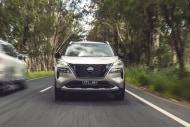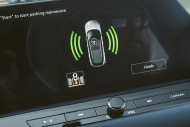
Why a surround-view camera can help with parking
A surround-view camera or 360-degree view camera is a multi-camera system that allows you to see the area around your entire car, not just behind it, as you would with a reverse- or rear-view camera.
A surround-view camera or 360-degree view camera is a multi-camera system that allows you to see the area around your entire car, not just behind it, as you would with a reverse- or rear-view camera.
- Surround-view camera systems offer a better all-around view of your car
- They can make parking a lot easier, if the system is good
- They aren’t perfect - some people prefer a reversing camera
These all-around camera systems can be super helpful for those who are not yet confident about the size of their car - indeed, they are a hugely valuable piece of technology in larger vehicles and SUVs, as you get a “birds-eye view” of the car and what’s around it.

These cameras go by a few different names, depending on the brand that fits the tech. Some examples include 360-Surround, Bird’s-eye view, Surround-View, Multi-Around View and more.
And while this type of camera system is a nifty innovation, there are some takes on the theme that aren’t as good as others. A few French brands use a “270-degree” view system, which will actually fill in the view around the car as you reverse, effectively negating the need for the system in the first place.
Other brands offer an augmented reality view of the car in its surroundings, which can actually be more disorienting than just looking at the top-down, overhead view. Some of this is no doubt “wait til I show you my car’s cool camera” fodder, but it is still arguably better to have the tech than not.
They can be good and bad when it comes to parking, though.

That’s because a reverse-view camera will, typically, fill the entire media screen when you engage reverse or hit the camera button. But with a surround-view camera, because the orientation is in portrait (that’s the way your brain works), you will see most camera systems have limitations to the size of the image display.
Some brands have managed to get around this by offering two separate views. On one part of the screen you will see either a forward, kerb or reverse camera, while the other part will show you a surround-view look at the car.
What you find to be best for you will simply depend on your preferences. There are some brands that offer high-quality surround-view camera systems from relatively low in the model range - the GWM Haval Jolion and H6, for instance, while the Nissan Qashqai has one of the best examples of a surround-view camera available from the second-spec (ST+) grade up.

Some people find that camera systems are only really useful when there are parking sensors involved in the parking scenario, too. There are brands that still offer camera only setups (some Toyota models and Subaru models, for instance), while others offer front, rear and side parking sensors along with a surround-view camera to help you ensure that you can park safely.
It’s still worth noting that a cautionary glance around your parked car is something you should try and do every time. A camera only tells so much of the truth, and if you’re looking at a top-down view from a camera that is designed with a broad-spectrum view in mind, and yet it’s taking up just a couple of centimetres of space on the vehicle’s media display, you might well miss something that you could have seen if you’d walked around the car before leaving.
Please take care while parking.

More Urban Guide


